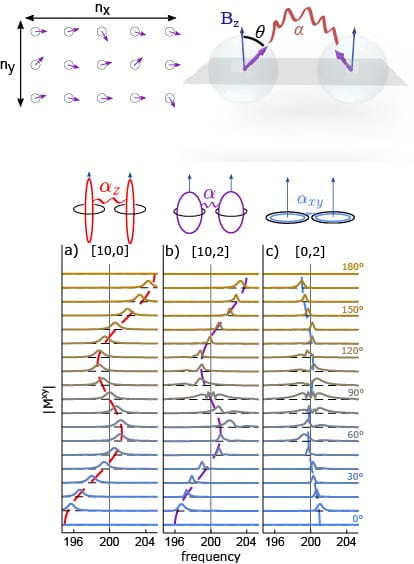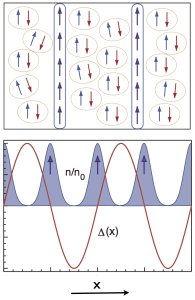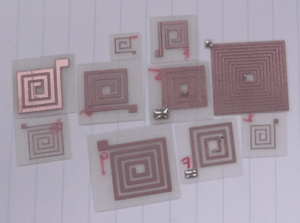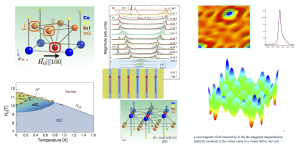We are in a constant search of yet unexplored quantum physical phenomena. The goal of our microscopic studies is to offer valuable input for development of novel theoretical models and guidance in the design of materials with targeted physical properties. Moreover, we study ways in which such quantum properties can be harnesses to develop functional non-linear devices for quantum microelectronics.
Why NMR?
Many novel quantum phases of matter have been revealed in strongly correlated electron systems. A complex array of these often competing phases leads to emergent phenomena. As many of the phases are associated with the breaking of the same symmetry, they are difficult to discern in bulk measurements of the thermodynamic properties. Consequently, little is known about the microscopic nature of these emergent phases, and theoretical models for their description that should involve a complex interplay between charge/orbital, spin, and lattice degrees of freedom, are lacking. Therefore, understanding of these complex phenomena requires the implementation of microscopic experimental tools that are simultaneously sensitive to all of the above degrees of freedom. NMR is perfectly suited for this thanks to its unique sensitivity to both magnetic and charge/orbital excitations at the relevant low energy scales. These low energy excitations are visible signatures of the underlying ground state and their study allows quantitative comparison with theory.
Harnessing the Data Revolution for the Quantum Leap: From Quantum Control to Quantum Materials
As ever larger and more complex quantum devices are constructed, a key challenge is to control them in a way that preserves their fragile quantum nature. To achieve the required level of control, it is essential to precisely identify crucial properties and features of the quantum system, material, or process of interest. This collaborative effort focuses on the use of novel data science methods to address two key challenges in quantum science: (1) System identification and quantum control of complex systems; and (2) Many-body simulation of quantum materials. Specifically, our work consists of extending the domain of applicability of quantum information science (QIS) theories to the many degrees of freedom present in real materials.
Modeling of spin dynamics
We are working on the development of the advanced numerical methods to model complex spin dynamics. These tools are employed to establish novel probes of elusive quantum orders and collective interactions of electrons with quantum materials.

We aim to understand the effects of collective electronic excitations on an ensemble of otherwise non-interacting nuclear spins. Our work differs from previous studies of weak and short-range inter-nuclei couplings, which usually only perturb the bandwidth or shift of NMR signals. The pulse and orientation dependence of these non-linear responses gives clues to the strength of the coupling as well as any spatial asymmetries of the coupling mode. Comprehensive understanding of this effect opens a new avenue for sensing and characterizing electronic phases. By applying machine learning techniques to our simulated NMR curves, we have generated models which can classify the form of the interaction with over 90% accuracy and predict its effective strength and interaction length.

We developed methodology for probing the details of electronic susceptibility through minimally invasive nuclear magnetic resonance techniques. Specifically, we classify electron-mediated long-range interactions in an ensemble of nuclear spins by revealing their effect on simple spin echo experiments. We find that the pulse strength and applied field orientation dependence of these spin echo measurements resolves the spatial extent and anisotropy of electronic spin susceptibility.
Development of Novel Probes of Emergent Quantum Orders
PULSEE
We are developing an open-source software for the simulation of observables in magnetic resonance experiments, including nuclear magnetic/quadrupole resonance NMR/NQR and electron spin resonance (ESR) to assist experimental research in the design of new strategies for the investigation of fundamental quantum properties of materials, as inspired by magnetic resonance protocols that emerged in the context of quantum information science (QIS).  The package introduced here enables the simulation of both standard NMR spectroscopic observables and the time-evolution of an interacting single-spin system subject to complex pulse sequences, i.e. quantum gates. The main purpose of this software is to facilitate in the development of much needed novel NMR-based probes of emergent quantum orders, which can be elusive to standard experimental probes. The software is based on a quantum mechanical description of nuclear spin dynamics in NMR/NQR experiments and has been widely tested on available theoretical and experimental results. Moreover, the structure of the software allows for basic experiments to easily be generalized to more sophisticated ones, as it includes all the libraries required for the numerical simulation of generic spin systems. In order to make the program easily accessible to a large user base, we developed a user-friendly graphical interface, Jupyter notebooks, and fully-detailed documentation.
The package introduced here enables the simulation of both standard NMR spectroscopic observables and the time-evolution of an interacting single-spin system subject to complex pulse sequences, i.e. quantum gates. The main purpose of this software is to facilitate in the development of much needed novel NMR-based probes of emergent quantum orders, which can be elusive to standard experimental probes. The software is based on a quantum mechanical description of nuclear spin dynamics in NMR/NQR experiments and has been widely tested on available theoretical and experimental results. Moreover, the structure of the software allows for basic experiments to easily be generalized to more sophisticated ones, as it includes all the libraries required for the numerical simulation of generic spin systems. In order to make the program easily accessible to a large user base, we developed a user-friendly graphical interface, Jupyter notebooks, and fully-detailed documentation.
Spin squeezing
We explore how the spin squeezing ξ itself can act as a local probe of emergent orders in quantum materials.


Multi-modal NMR spectroscopy of phase transitions
We have developed a novel method that allows us to separate quantum fluctuations originating from either charge/orbital and/or spin channels as phase transitions is approached. This method allows us to probe type of quantum orders that are elusive to all standard experimental techniques.

In traditional magnetic resonance, the information about the local spin environment is encoded in the spectrum of the nuclear spins but can potentially be obscured by multiple sources of spectral broadening, including highly non-trivial multipolar exchange interactions, and/or zero local values of susceptibility. This is particularly relevant for materials that exhibit an emergence of exotic quantum phases that possess unusual symmetries and orderings, such as correlated materials with strong spin-orbit coupling, and whose order parameter has large variations and oftentimes zero mean. In such cases, standard probes around a phase transition are insensitive to variations in the local bilinear terms, presenting a serious obstacle in determining the broken symmetry. We have developed novel NMR approach, inspired by quantum control techniques that fully leveraged multi- dimensional spectroscopy, which manipulate single spin systems in order to refocus Hamiltonian terms only of specific desired symmetries during spin time evolution, used to solve the phase- transition measurement problem by directly measuring the distribution of symmetry breaking terms and not just their mean value. In contrast to conventional one-dimensional spectroscopy, which studies amplitudes as a function of an experiment time (t) and depends on the system’s energy levels, we directly extract an interaction parameter ω from the Hamiltonian through a variation of that interaction’s integration time (τ). When the ω values vary across a sample, the width of the distribution is easily recoverable from a decay timescale in the case of half-integer spins, even when the average value of ω is zero. This provides an ideal method for assessing the distribution and source of disorder above phase transition, specifically for “order from disorder” transitions which require large variations in an order parameter with zero mean. At the same time, the technique reveals any inversion or time-reversal symmetry among the local interactions, giving direct evidence on the form of the microscopic Hamiltonian.
Topological states of matter
The recently discovered topological insulator (TI) is a novel state of quantum matter and is characterized by time-reversal-symmetric gapless topological surface states, which appear within the bulk energy gap. The TI with tunable surface states are necessary for applications in spintronics and quantum computation. We are developing resistively detected NMR resonance techniques to directly probe spin degrees of freedom and role that spin-momentum-locking plays on transport properties of these surface states.
 Electron spins in edge or surface modes of topological insulators (TIs) with strong spin-orbit coupling cannot be directly manipulated with microwaves due to the locking of electron spin to its momentum. We show by contrast that a resistively detected nuclear magnetic resonance (RDNMR) based technique can be used to probe the helical nature of surface conducting states. In such experiments, one applies a radio frequency (RF) field to reorient nuclear spins that then couple to electronic spins by the hyperfine interaction.
Electron spins in edge or surface modes of topological insulators (TIs) with strong spin-orbit coupling cannot be directly manipulated with microwaves due to the locking of electron spin to its momentum. We show by contrast that a resistively detected nuclear magnetic resonance (RDNMR) based technique can be used to probe the helical nature of surface conducting states. In such experiments, one applies a radio frequency (RF) field to reorient nuclear spins that then couple to electronic spins by the hyperfine interaction.
Quantum Magnetism
Broadly speaking, this project represents the fundamental study of the quantum mechanics of the spin in strongly correlated electron systems.
Materials with strong spin-orbit coupling (SOC)
In Mott insulators with strong SOC, implying that spin itself is not a good quantum
number, various exotic quantum phases (for example, spin nematic, orbital and/or quadrupole orders) are predicted to emerge. Most of the phases are distinguishable by either local point symmetry breaking or local spin expectation values. In principle, these quantities are measurable by a local probe such as NMR (but not discernible in bulk magnetization).

Moreover, we explore effects of giant spin-orbit coupling and quantum confinement in functional and enabling nanoscale structures. These include studies of surface induced magnetic anisotropy and its enhancement via nanoscale and composite structures. The goal of our fundamental research part is to understand giant spin-orbit coupling, surface induced anisotropy, and electron interactions.
2D spin liquids
We deploy NMR to determine the microscopic spin texture and the nature of the low energy excitations in various magnetic field-induced phases in 2D frustrated quantum magnets. These results allow direct quantitative comparison with theory. We adopted and developed NMR probes to allow us to study such field induced quantum phase transitions at the NHMFL.

Furthermore, we use the NMR rate (two-spin correlation function) to infer nature of the spin liquid phases, distinct by the flux. Specifically, our results permit to deduce the underlying statistics (fermionic vs. bosonic) of low energy excitations and whether they are fractional in nature. Strong motivation for the study of such systems comes from the observation of superconductivity, possibly mediated by spin fluctuations, in doped materials with the same underlying lattice.
This project is carried out in collaboration with R. Coldea (Oxford, UK), A. Reyes (NHMFL), and theory group of B. Marston (Brown).
Novel Probes of Axions & Time-Reversal Symmetry Breaking
We are working on development of ultra-sensitive probes of magnetic fields (both fictitious and real ones) to enable design of table-top prototype experiments to quest for physics beyond the Standard Model. Specifically, we aim to develop novel ultra-sensitive devices for the detection of light dark matter candidate particles (i.e. Axion-like particles) that are only limited by the fundamental laws of quantum mechanics. Our proposed approach is orthogonal to current searches and is based on exploiting fundamental properties of quantum matter.
Superconductivity
Modulated Superconductivity – (FFLO)
Applied magnetic fields tend to align the spins, whereas the spins in a Cooper pair, in its simplest form, are antiparallel. Those antagonistic tendencies lead to pair breaking.
When the pair breaking effect (magnetic field) is sufficiently large, a Cooper pair has two options for “survival”. It can become a triplet pair, in which the two spins point in the same direction with the magnetic field, or it can remain in the singlet state with the spins pointing in opposite directions and acquire instead a finite momentum. This momentum leads to a spatially modulated state consisting of periodically alternating “normal” and “superconducting” regions. We are studying nature of superconducting states in high magnetic fields, and how such states interact with vortices.

This work is carried out in collaboration with the NMR group at the French National High Magnetic Field Laboratory in Grenoble, France, lead by Dr. C. Berthier & Dr. M. Horvatic.
Unconventional superconductivity, magnetism, and vortex states
The discovery of the CeMIn5 family of materials almost ten years ago sparked a strong research interest since they provide the ground for the study of many big puzzles of strong correlated electron physics, such as quantum criticality, unconventional superconductivity and quantum magnetism. We are particularly interesting in studying nature of coexistence of inherently competing orders, magnetism and superconductivity. NMR provides an exceptional experimental tool for the investigation of such problems since it allows us to separately probe superconducting and magnetic degrees of freedom.
Semiconductors
Transparent oxyde – semiconductors
We are studying microscopic properties of Sn doped In-oxydes.  This project is carried out in collaboration with Prof. David Paine, whose group synthesizes these materials and performs characterization of bulk properties. Combining our microscopic and bulk findings allows us to determine the roles of oxygen-vacancy dynamics, valence fluctuations, and impurity sub-gap states in determining bulk transport properties.
This project is carried out in collaboration with Prof. David Paine, whose group synthesizes these materials and performs characterization of bulk properties. Combining our microscopic and bulk findings allows us to determine the roles of oxygen-vacancy dynamics, valence fluctuations, and impurity sub-gap states in determining bulk transport properties.
Technical Developments
Design and development of cryogenic probe for low-noise, high-frequency electronic measurement
We designed and characterized the performance of a low-noise, modular cryogenic probe, applicable to a wide range of measurements over a broad range of working frequencies, temperatures, and magnetic fields is presented. The design of the probe facilitates the exchange of sample holders and sample-stage amplifiers, which, combined with its characteristic low transmission and reflection loss, make this design suitable for high precision or low sensitivity measurements. The specific example of measuring the shot noise of magnetic tunnel junctions is discussed.

Surface coils
We are exploring ways of using surface coils to efficiently probe 2D-like samples. For example, the meander-line coil is a serpentine array of parallel conductors. The effective RF field is confined to a region adjacent to the coil and its penetration depth is determined only by the spacing between parallel conductors. Since the signal-to-noise ratio in an NMR experiment is proportional to the filling fraction (ratio of the volume of the effective RF field to the sample volume), the meander-line coils are ideally suited for probing thin 2D-like samples or for probing sizable surface area to a limited depth.
The effective RF field is confined to a region adjacent to the coil and its penetration depth is determined only by the spacing between parallel conductors. Since the signal-to-noise ratio in an NMR experiment is proportional to the filling fraction (ratio of the volume of the effective RF field to the sample volume), the meander-line coils are ideally suited for probing thin 2D-like samples or for probing sizable surface area to a limited depth.
Piezo resonance
We are developing piezoelectric resonance technique to allow us to efficiently probe anisotropy of magnetic nanoparticles.
Industrial Collaborations
- Millikelvin Technologies
- IBM T. J. Watson Research Center
- Sofar Acoustics



